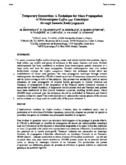| dc.contributor.author | Berthouly, M. | |
| dc.contributor.author | Charmetant, P. | |
| dc.contributor.author | Bertrand, B. | |
| dc.contributor.author | Barry-Etienne, D. | |
| dc.contributor.author | Vásquez, N. | |
| dc.contributor.author | Lartaud, M. | |
| dc.contributor.author | Nyange, N. | |
| dc.contributor.author | Etienne, H. | |
| dc.date.accessioned | 2014-10-18T03:33:33Z | |
| dc.date.available | 2014-10-18T03:33:33Z | |
| dc.date.issued | 2001 | es_ES |
| dc.identifier | 337030 | es_ES |
| dc.identifier.uri | https://repositorio.catie.ac.cr/handle/11554/4190 | |
| dc.description | 7 ilus. 3 tab. 17 ref. | es_ES |
| dc.description.abstract | In many countries Coffea arabica breeding creates and selects hybrids that combine vigour, high yields, cup quality and genes of resistance to the major diseases and pests. Somatic embryogenesis has been considered to evaluate these heterozygous genetic structures on a large scales, and later for mass propagation. Somatic embryogenesis may also replace horticultural cuttings for Coffea canephora. Finally this technique would allow fast establishment of clonal seed gardens. This work allowed us to optimise the various phases of the process and to evaluate on a large scale the conformity of the plants obtained. | es_ES |
| dc.language.iso | en | es_ES |
| dc.publisher | CATIE, Turrialba (Costa Rica) | es_ES |
| dc.subject | COFFEA | es_ES |
| dc.subject | GENOTIPOS | es_ES |
| dc.subject | HETEROCIGOTOS | es_ES |
| dc.subject | EMBRIOGENESIS SOMATICA | es_ES |
| dc.subject | INMERSION | es_ES |
| dc.title | Temporary immersion: a technique for mass propagation of heterozygous Coffea spp. genotypes through somatic embryogenesis | es_ES |
| dc.type | MON | es_ES |
| dc.identifier.publication | Turrialba (Costa Rica) | es_ES |


